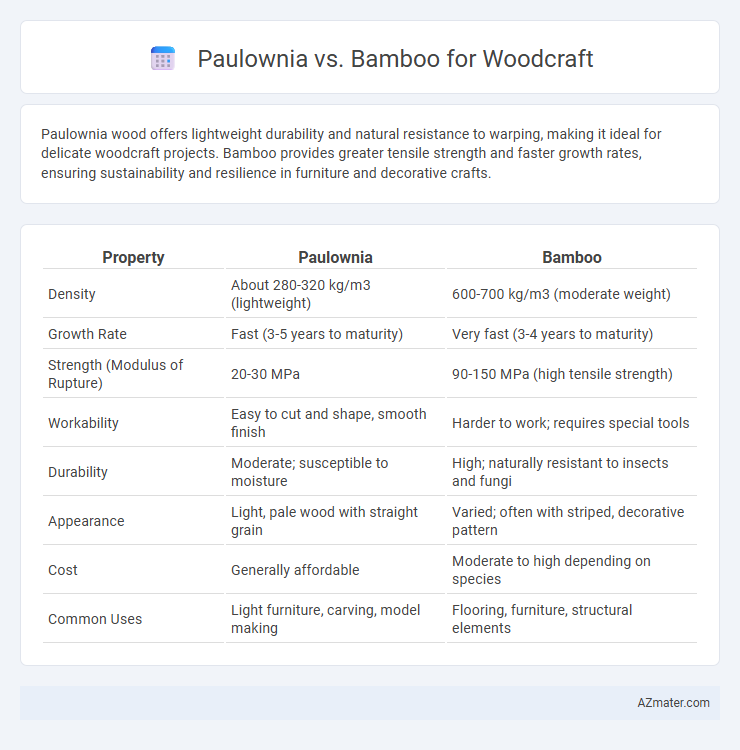Paulownia wood offers lightweight durability and natural resistance to warping, making it ideal for delicate woodcraft projects. Bamboo provides greater tensile strength and faster growth rates, ensuring sustainability and resilience in furniture and decorative crafts.
Table of Comparison
| Property | Paulownia | Bamboo |
|---|---|---|
| Density | About 280-320 kg/m3 (lightweight) | 600-700 kg/m3 (moderate weight) |
| Growth Rate | Fast (3-5 years to maturity) | Very fast (3-4 years to maturity) |
| Strength (Modulus of Rupture) | 20-30 MPa | 90-150 MPa (high tensile strength) |
| Workability | Easy to cut and shape, smooth finish | Harder to work; requires special tools |
| Durability | Moderate; susceptible to moisture | High; naturally resistant to insects and fungi |
| Appearance | Light, pale wood with straight grain | Varied; often with striped, decorative pattern |
| Cost | Generally affordable | Moderate to high depending on species |
| Common Uses | Light furniture, carving, model making | Flooring, furniture, structural elements |
Introduction to Paulownia and Bamboo in Woodcraft
Paulownia and bamboo are highly valued in woodcraft for their unique properties and sustainability. Paulownia wood is lightweight, rapidly renewable, and resistant to warping, making it ideal for furniture and decorative carvings. Bamboo, a fast-growing grass, offers exceptional strength and flexibility, often used in flooring, furniture, and eco-friendly construction projects.
Botanical Characteristics and Growth Rates
Paulownia wood is prized for its lightweight and fine grain, derived from a fast-growing deciduous tree with broad, heart-shaped leaves and large violet flowers. Bamboo, a grass species rather than a tree, exhibits rapid vertical growth and regenerates quickly due to its rhizome-based root system, making it highly sustainable. Both Paulownia and bamboo offer exceptional growth rates, but Paulownia typically reaches maturity in 7-10 years, whereas bamboo can be harvested within 3-5 years, influencing their suitability for different woodcraft applications.
Sustainability and Environmental Impact
Paulownia wood offers exceptional sustainability due to its rapid growth rate, absorbing significant amounts of CO2 while requiring minimal water and pesticides, making it an eco-friendly choice for woodcraft. Bamboo, a grass rather than a tree, regenerates quickly without replanting, promotes soil health, and sequesters carbon efficiently, contributing to reduced deforestation pressures. Both materials provide renewable alternatives with low environmental footprints, but Paulownia's lighter weight and bamboo's fibrous strength cater to different woodcraft needs.
Workability and Ease of Handling
Paulownia wood is lightweight with a fine, straight grain, making it exceptionally easy to cut, shape, and sand, ideal for intricate woodcraft projects. Bamboo, while tougher and denser, requires specialized tools for splitting and shaping but offers superior durability and a unique aesthetic for handcrafted items. Both materials provide versatility, but paulownia stands out in ease of handling for beginners and detailed work, whereas bamboo suits projects demanding strength and resilience.
Strength and Durability Comparison
Paulownia wood exhibits a remarkable strength-to-weight ratio, making it lightweight yet durable for intricate woodcraft projects, while bamboo's natural fiber composition provides exceptional tensile strength and flexibility suitable for sturdy furniture and structural applications. In terms of durability, Paulownia resists warping and cracking but is more susceptible to insect damage unless properly treated, whereas bamboo offers superior resistance to moisture and pests due to its dense, silica-rich fibers. Selecting between Paulownia and bamboo depends on specific project requirements, with Paulownia favored for ease of carving and lightweight properties and bamboo chosen for long-lasting outdoor durability and high mechanical strength.
Weight and Density Differences
Paulownia wood is significantly lighter than bamboo, with a density ranging between 0.25 to 0.35 g/cm3 compared to bamboo's higher density of approximately 0.6 to 0.9 g/cm3. This lower density makes paulownia ideal for lightweight woodcraft projects requiring ease of handling and transportation. Bamboo's greater density provides superior strength and durability, making it preferable for items needing structural integrity and resistance to wear.
Aesthetic Qualities: Grain, Color, and Texture
Paulownia wood features a fine, straight grain with a light, creamy color that enhances its natural brightness and smooth texture, making it ideal for intricate woodcraft designs. Bamboo exhibits a more pronounced, linear grain with a warm, golden hue and a firm, slightly fibrous texture that adds rustic charm and durability to handcrafted pieces. Both materials offer unique aesthetic qualities where Paulownia's subtle elegance contrasts with Bamboo's vibrant and tactile appearance, catering to different artistic preferences in woodcraft.
Common Applications in Woodcraft
Paulownia wood is favored in woodcraft for lightweight furniture, musical instruments, and decorative carvings due to its soft texture and easy workability. Bamboo, known for its tensile strength and flexibility, is commonly used in making flooring, furniture, and intricate woven crafts. Both materials offer sustainable options, with Paulownia excelling in fine detail work and Bamboo preferred for structural applications.
Cost and Availability Analysis
Paulownia wood is generally more expensive than bamboo due to slower growth rates and limited regional availability, impacting initial investment costs for woodcraft projects. Bamboo offers cost-effective, rapid-renewable material with widespread global availability, making it a preferred choice for budget-conscious artisans. Price fluctuations for Paulownia often stem from supply constraints and niche market demand, whereas bamboo maintains stable pricing driven by large-scale cultivation and efficient harvesting methods.
Conclusion: Choosing the Right Wood for Your Project
Paulownia offers lightweight, softwood qualities ideal for carving and detailed woodcraft, while bamboo provides superior strength and flexibility for more structural or outdoor projects. Selecting the right material depends on factors like durability, grain texture, and moisture resistance suited to the specific woodcraft application. For lightweight, easy-to-shape pieces, Paulownia is preferable, whereas bamboo excels in strength-demanding or eco-friendly designs.

Infographic: Paulownia vs Bamboo for Woodcraft
 azmater.com
azmater.com